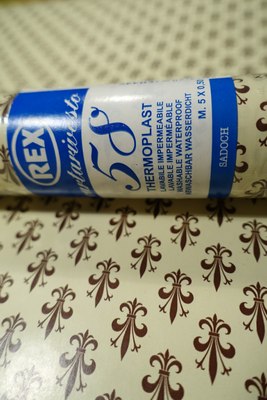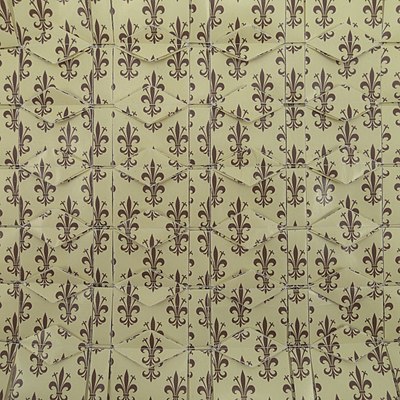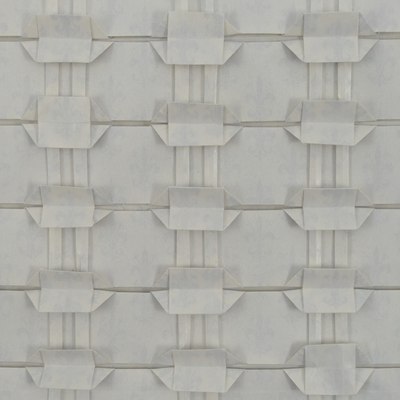Rex Sadoch Thermoplast Paper Review



In 2018, when visiting Italy for the CDO convention, I bought a roll of interesting-looking patterned paper at a store (not related to origami). I’m not even quite sure what the paper’s official name is since there are many labels that look like names on the package, and despite one saying Thermoplast, which could be the name, the producer’s web page refers to this paper as carta rivesto which I understand as coated paper. I tested this paper back in 2019, but it took me until now to publish the review.
The paper is patterned with fleur-de-lis (⚜) on a beige-yellow background on one side while the back is smooth and a neutral cream color. Many other patterns are available. Unfortunately, the pattern, though really nice, did end up distracting from the folded tessellation as I had feared. Probably with larger molecules, this effect would be less pronounced. One can easily notice that the pattern is printed only skin-deep since tiny particles of paint dust peeled off from the crease during folding and were clearly visible on my bone folder and hands. In the precreased sheet, creased lines are clearly visible as having the paint torn off. Surprisingly, this did not negatively affect the finished model, perhaps because the paint comes off only in a very narrow and clean strip right along the crease, or because the pattern masks all minor details. I haven’t tried in practice, but perhaps the plain back side would make nice models without the distracting pattern and with creases ideally matching the color of the paper.
The stated paper weight is 60-65 gsm, and it feels relatively thin indeed. Precreasing went well and creases were easy to reverse. It was also easy to fold small details: the thinnest pleats in the model correspond to a 128 grid (on a 30 cm sheet) and I had no trouble folding them at all. It didn’t feel very strong, but I did not test strength that much since this particular model did not put much stress on the paper. The sheet slightly adhered to my table electrostatically. The producer’s booklet presents lining shelves as an example of this paper type’s usage, and such behavior may help with that. It didn’t affect my folding in any noticeable way, but it was interesting. The only other type of paper with such behavior that I have seen is electrostatic paper used for taking notes that you can just stick to a glass wall or a whiteboard in an office without any glue.
The collapse went mostly OK, but it could have been easier: the paper felt a little too thin, despite being quite crispy. In the end, however, all folds went where they should and the end result is neat. Apart from Rhombi Rows, I also folded a Fujimoto Hydrangea from this paper and for that model, the collapse didn’t pose any issues (precreasing, folding, and reversing the pyramids all went very well, too).
The coating is supposed to make the paper washable. I tested this by putting a sheet (not the one used for this model) under a stream of water from the tap. A small area around the edges got soaked, but the center did not soak water. Given that this was under a big stream of water, if the paper was just cleaned with a moist cloth, it would probably not soak water at all, so the claim to being washable seems to be true.
Overall, this was an interesting paper to try. It has a number of nice properties and seems well suited for models based on big grids or those with fine details but which do not put much stress on the paper during precreasing and collapse. For this tessellation, the pattern was certainly too strong, but for figurative models or geometric models with larger elements, it may be fine. I also need to check what models will look like when the non-patterned back side of the paper is exposed.
Comments